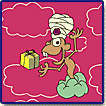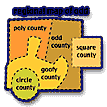Photoshop
6/ImageReady 3 Hands-On Training
"Covers
Photoshop 6 and ImageReady 3 in a Thorough and Concise Manner!"

Title:
Photoshop
6/ImageReady 3 Hands-on Training
Author: Jan
Kabili , Lynda Weinman
Publisher:
Peachpit Press http://www.peachpit.com
Publication Date: July
2001
Pages: 672
with CD
ISBN: 0-201-72796-X
Price:
$49.99
Photoshop 6/ImageReady 3 Hands-On-Training describes techniques for creating Web graphics and animations using Photoshop 6 and ImageReady 3. This book mainly focuses on using Photoshop specifically for Web graphics. Lynda Weinman and co-author Jan Kabili share their favorite insider tricks on how to create optimized Web JPEGs and GIFs, complex rollovers, animations, buttons, backgrounds, and image maps in an easy-to-digest tutorial style. Unlike other books on the subject, it is as much about using ImageReady as it is about Photoshop. If you want to learn how to save time while creating Web graphics, keep your file sizes as small as possible, generate HTML pages right out of ImageReady, use layer effects to your advantage, or any number of other tricks — then this is the book for you.
It is appropriate for both PC and Macintosh users. Check out the Peachpit Press Web site (http://www.peachpit.com) for more information about the book and other books in the Hands-On-Training series. Also check out Lynda Weinman's Web (http://www.lynda.com) site for information on her other books and classes.
Inside you'll find information on the following:
- Rollovers
- Animation
- Image Maps
- Transparency
- Backgrounds
- Buttons
- Styles
- Slicing
- Layer Styles
- Automation Techniques
Photoshop 6/ImageReady 3 Hands-on Training is divided into an introduction and 16 chapters.
Introduction--describes basics about how the book works and background on the authors.
Chapters 1 through 16 cover the following:
- Chapter 1: Interface--discusses: Color Profiling in Photoshop 6; sRGB in Photoshop 6; Setting Photoshop Color Settings; Changing Photoshop Preferences for the Web; Interface Overview; Toolboxes; Fly Out Menus; Jump To Buttons; Using Flexible Palettes and Tabs; Docking Palettes; Using the Options Bar; Shortcuts. The chapter has nine exercises and charts on: Photoshop 6 and ImageReady 3 Toolboxes; and Shortcuts.
- Chapter 2: Web Color--discusses: Web-Safe Color; Changing the Info Palette; Copy Color as HTML; Snapping to Web Colors; Loading the lynda.com Swatch; Previewing Browser Dither; Fixing a Non-Safe Image; Recoloring Layered Documents; Filling with DitherBox; and Previewing Gamma. There are thirteen exercises, and there are charts on: RGB Color Translation Values; RGB Color Translations; Lock Checkboxes; and Color Settings.
- Chapter 3: Optimization--presents information on: What Affects Speed on the Web; GIF or JPEG; GIF Transparency and Animation; Lossy or Lossless; How Can You Make Small JPEGs and GIFs; What About PNG; Bit Depth; Saving Options; Saving for Web Using GIF and JPEG; Choosing the Right Palette; The Meaning of Perceptual, Selective, Adaptive, and Web; When Dithering is Good; Locking Colors; Changing the Dimensions of a Graphic; Selective GIF Optimization with Alpha; Previewing in a Browser; ImageReady versus Photoshop Workflow; Using a Matte Color on a JPEG; and Previewing and Writing HTML. There are sixteen exercises. The chapter has charts on: GIF Definitions; JPEG Compression; GIF Compression; Bit-Depth; JPEG Context-Sensitive Properties; GIF Context-Sensitive Properties; Which Type of Save Is Best; Definitions; and When to Use Which Program. There are sixteen exercises.
- Chapter 4: Layers on Steroids--presents information on: Layer Basics; Moving and Linking Layers; Aligning Layers with Link Icon; Layer Sets; Solid Color Layer; Gradient Layer; Pattern Layer; Layer Masks; Adjustment Layer; and Clipping Groups. It includes a chart on Flattening Photoshop Files. It has ten exercises. See the top image to the left for a view of an image that contains a photographic image inside text.
- Chapter 5: Type--gives you information on: Differences in Type in Photoshop 6 and ImageReady 3; Type Options Bar; Using the Character Palette; Using the Paragraph Palette; Warped Text; Rasterizing Type; and Transforming Type. There are two charts: Charter Settings; and Using Free Transform with your Mouse. The chapter has seven exercises.
- Chapter 6: Layer Styles--shows: Bitmaps and Vectors; Shape Tools; Creating Layer Styles; Layer Style Dialog Box; Saving a Custom Layer Style; and Applying Styles from the Styles Palette. Informational charts of Bitmap Versus Vector; Shape Tool Functionality; and Layer Style Terms are included. There are four exercises.
- Chapter 7: Background Images--shows: Background Image Sizes; Defining, Editing, and Previewing a Background Image; Saving a Background Image; Recoloring Background Image Artwork; Seamless Background Tiles; Save Options in ImageReady; Copying and Pasting with Offset; Ways to Access the Offset Filter in ImageReady; Seamless Photographic Background Images; Full-Screen Graphic Background Images; Large-Screen Photographic Background Images; and Directional Tiles. The chapter has charts on: Save Options: and Offset Filter. It has nine exercises.
- Chapter 8: Transparent GIFs--provides information on: Problems with GIF Transparency; Anti-Aliasing; How to Recognize a Transparent Layer; Transparency, Masks, and GIFs; Creating and Previewing GIF Transparency; Fixing Bad Edges; Adding a Drop Shadow Over a Fine-Toothed Background; The Pitfalls of Broad Backgrounds; Saving Transparent Images; Transparent Layer Versus Transparent GIF; and Offset Problems in Browsers. The chapter has a chart on Transparency Terminology. It has seven exercises. See the middle image to the left for a view of a transparent monkey image that was placed over a cloud background.
- Chapter 9: Image Maps--covers: Server-Side or Client-Side; What is an Image Map; Making an Image Map; and Jumping to Photoshop with an Image Map. There are no charts. The chapter has four exercises. See the bottom image to the left that shows an image that you use to create an image map with Photoshop's image map drawing tools.
- Chapter 10: Slicing--covers: What are Slices; Slice Types; Slicing and Selecting; Optimizing Slices; Previewing and Saving Slices; and Using Slice Options. There are no charts. The chapter has four exercises.
- Chapter 11: Rollovers--describes: Single-Button Rollover without Slicing; Slice Before You Rollover; Setting No-Image Slices; Saving a Rollover; Output Settings for Saving Rollovers; Image Map-Based Rollovers; Single-Button Rollover with Layer Visibility; What JavaScript States Are Allowed in ImageReady; Remote Rollovers; and Saving Complicated Rollovers. The chapter has charts on: File Naming Options; File Optimization Options; and JavaScript Rollover States. It has eight exercises.
- Chapter 12: Layer-Based Rollovers--includes information on: Creating a Layer-Based Slice with a Rollover; Moving a Rollover in a Layer-Based Slice; Promoting a Layer-Based Slice; Creating Navigation Bar Artwork in Layers; Aligning Layers; Using Rollover Styles; Creating a Custom Rollover Style; and Applying Your Rollover Style to Your Buttons. It includes charts on: Code View Options; and the Different Selections Available Under the Clean Up HTML Command. It has eight exercises.
- Chapter 13: Animated GIFs--provides information on: Animation Terms; Animated GIF Format; Compression Challenges; Controlling the Timing of Animated GIFs; Animation Aesthetics; Frame-by-Frame Animation with Layers; Setting the Speed and Looping; Optimizing and Saving an Animated GIF; Making a Transparent Animated GIF; Tweening with Opacity; Selecting, Duplicating, and Reversing Frames; Different Ways to Duplicate Frames; Tweening a Tweened Sequence; Tweening with Position or Effects; Animated Slide Show; Animated GIF Rollovers; and Designing Entire Interfaces. The chapter has a chart on Methods for Duplicating Frames. It has twelve exercises.
- Chapter 14: Automation--presents information on: Web Photo Gallery; Actions in Photoshop; Actions in ImageReady; Batch Processing with an Action; Adding, Changing, Deleting, or Pausing an Action; Creating a Preview in Browser Action; Droplets; and Changing Droplets. The chapter has charts on: Web Photo Gallery Settings; and Working with Actions. It has six exercises.
- Chapter 15: Importing/Exporting--describes: Update HTML in ImageReady; Getting ImageReady Rollovers into GoLive; Getting ImageReady Rollovers into Dreamweaver; Exporting Illustrator 9 Files; Exporting from Earlier Illustrator Versions; Exporting ImageReady to QuickTime; and Converting from QuickTime to ImageReady. There are no charts. The chapter has seven exercises.
- Chapter 16: Troubleshooting FAQ--gives you frequently asked questions and answers and where to go for further help.
Photoshop 6/ImageReady 3 Hands-on Training helps you learn the programs but also gets your creative juices running and encourages you to experiment. The short, simple exercises help you easily absorb the information, and they are paced so that you can take breaks and try what was just learned. You can't go wrong with this book.
For running Photoshop 6 and ImageReady 3, you need:
Windows
- Pentium or faster Intel processor
- Windows 98, Windows Millennium, Windows 2000 or Windows NT 4.01
- 64 MB of RAM (128 MB required to run Photoshop and ImageReady concurrently)
- 125 MB of available hard-disk space
- Color
monitor with 256 color (8-bit) or greater video card
800x600 or greater monitor resolution - CD-ROM drive
Macintosh
- PowerPC processor
- Mac OS software version 8.5, 8.6, or 9.0
- 64 MB of RAM w/Virtual Memory on (128 MB required to run Photoshop and ImageReady)
- 125 MB of available hard-disk space
- Color
monitor with 256 color (8-bit) or greater video card
800x600 or greater monitor resolution - CD-ROM drive
Web Page Design: Macromedia Dreamweaver 4.0
| Educational | Books | Utilities | Web Tools | Legal | Articles


